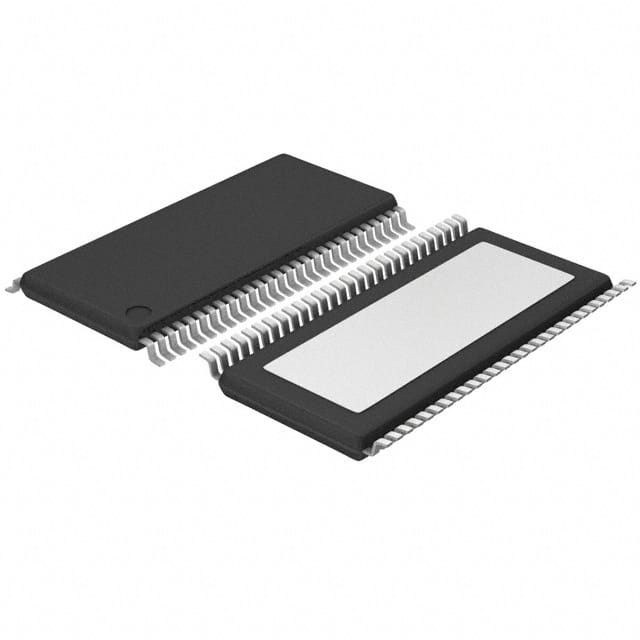TLC5955DCAR
Product Overview
Category
The TLC5955DCAR belongs to the category of LED driver integrated circuits.
Use
It is primarily used for controlling and driving LEDs in various applications.
Characteristics
- High precision grayscale PWM control
- Wide range of output current adjustment
- Daisy-chainable for easy scalability
- Built-in error detection and protection features
- Low power consumption
- High refresh rate for smooth LED animations
Package
The TLC5955DCAR comes in a small outline package (SOIC) with 56 pins.
Essence
The essence of the TLC5955DCAR lies in its ability to efficiently drive and control multiple LEDs, providing precise and customizable lighting solutions.
Packaging/Quantity
The TLC5955DCAR is typically packaged in reels and available in quantities of 2500 units per reel.
Specifications
- Supply voltage: 3.3V - 5.5V
- Output current: Up to 60mA per channel
- Number of channels: 48
- Communication interface: Serial data input/output
- Operating temperature range: -40°C to +85°C
Detailed Pin Configuration
The TLC5955DCAR has a total of 56 pins, each serving a specific purpose. The pin configuration is as follows:
- VCC
- GND
- SOUT
- SIN
- SCLK
- XLAT
- BLANK
- GSCLK
- OUT0
- OUT1
- OUT2
- OUT3
- OUT4
- OUT5
- OUT6
- OUT7
- OUT8
- OUT9
- OUT10
- OUT11
- OUT12
- OUT13
- OUT14
- OUT15
- OUT16
- OUT17
- OUT18
- OUT19
- OUT20
- OUT21
- OUT22
- OUT23
- OUT24
- OUT25
- OUT26
- OUT27
- OUT28
- OUT29
- OUT30
- OUT31
- OUT32
- OUT33
- OUT34
- OUT35
- OUT36
- OUT37
- OUT38
- OUT39
- OUT40
- OUT41
- OUT42
- OUT43
- OUT44
- OUT45
- OUT46
- OUT47
Functional Features
- Grayscale PWM control: The TLC5955DCAR allows precise control of the grayscale levels of each LED, resulting in smooth and accurate color reproduction.
- Output current adjustment: It provides a wide range of output current adjustment options, allowing flexibility in driving LEDs with different power requirements.
- Daisy-chainable: Multiple TLC5955DCAR ICs can be easily connected in a daisy-chain configuration, simplifying the wiring and scalability of LED arrays.
- Error detection and protection: Built-in error detection mechanisms help identify and protect against potential issues such as overtemperature, open/short circuit, and undervoltage conditions.
- Low power consumption: The TLC5955DCAR is designed to operate efficiently, minimizing power consumption while delivering optimal performance.
- High refresh rate: With a high refresh rate, it ensures smooth and flicker-free LED animations.
Advantages and Disadvantages
Advantages
- Precise grayscale control for accurate color representation
- Flexible output current adjustment for various LED types
- Easy scalability through daisy-chaining
- Built-in error detection and protection mechanisms
- Efficient power consumption
- Smooth LED animations with high refresh rate
Disadvantages
- Limited number of output channels (48)
- Requires external components for proper operation
- Relatively higher cost compared to simpler LED driver solutions
Working Principles
The TLC5955DCAR operates based on the principle of pulse-width modulation (PWM). It receives serial data input, which contains information about the desired grayscale levels for each LED. The IC then converts this data into precise PWM signals, controlling the current flowing through the LEDs. By adjusting the duty cycle of these PWM signals, the TLC5955DCAR achieves accurate grayscale control.
Detailed Application Field Plans
The TLC5955DCAR finds applications in various fields, including:
- Automotive lighting systems: It can be used to drive and control LEDs in automotive headlights, taillights, and interior lighting.
- Display panels: The TLC5955DCAR enables precise control of LEDs in large display panels, such as those used in stadiums or advertising billboards.
- Architectural lighting: It is suitable for architectural lighting installations, allowing dynamic and customizable
Lista 10 Vanliga frågor och svar relaterade till tillämpningen av TLC5955DCAR i tekniska lösningar
Sure! Here are 10 common questions and answers related to the application of TLC5955DCAR in technical solutions:
Q: What is TLC5955DCAR? A: TLC5955DCAR is a high-performance, 48-channel constant current LED driver that can be used for driving LEDs in various applications.
Q: What is the maximum output current of TLC5955DCAR? A: The maximum output current of TLC5955DCAR is 120 mA per channel.
Q: Can TLC5955DCAR drive RGB LEDs? A: Yes, TLC5955DCAR can drive RGB LEDs as it supports individual control of each channel.
Q: What is the communication interface supported by TLC5955DCAR? A: TLC5955DCAR supports serial communication using the SPI (Serial Peripheral Interface) protocol.
Q: Can TLC5955DCAR be cascaded to drive more than 48 LEDs? A: Yes, multiple TLC5955DCAR devices can be cascaded together to drive a larger number of LEDs.
Q: Does TLC5955DCAR have built-in grayscale control? A: Yes, TLC5955DCAR has built-in 16-bit grayscale control, allowing precise control over the brightness levels of each LED.
Q: What is the supply voltage range for TLC5955DCAR? A: The supply voltage range for TLC5955DCAR is typically between 3.3V and 5.5V.
Q: Can TLC5955DCAR be used in automotive applications? A: Yes, TLC5955DCAR is suitable for automotive applications as it operates over a wide temperature range and has ESD protection.
Q: Is there any thermal protection feature in TLC5955DCAR? A: Yes, TLC5955DCAR has built-in thermal shutdown protection to prevent overheating.
Q: What are some typical applications of TLC5955DCAR? A: TLC5955DCAR can be used in applications such as LED displays, signage, architectural lighting, automotive lighting, and more.
Please note that these answers are general and may vary depending on the specific implementation and requirements of your technical solution.


